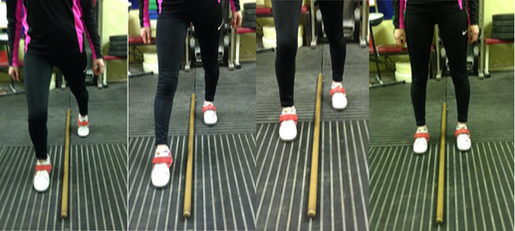AuthorA 20 year old fitness enthusiast and dedicated Olympic style weightlifter. I am a Level 2 Weightlifting coach, Powerlifter, and non-competitive Irish dancer. I'm determined to live a healthier lifestyle and take care of my body whilst influencing other young people to do so. I never doubt my ability to achieve something; I just change what I'm doing until I succeed. Archives
May 2021
|
Back to Blog
Olympic Weightlifting warmup24/1/2018 I had this idea a while back and even had the photos prepared except I didn't plan out the time I was going to write a post in between training three times a week (oops). Anyways, this post is about how I warm up the OASIS Weightlifting Squad before competitions and training. I also use this warm up before I train and I usually coach this to any new beginners with wooden poles. This is known as the reverse chain method created by Brian Hamill, however it isn't very popular around this time. The aim of the warm up is to promote the way the lifters should be lifting technique wise when training or competing. Please carry on reading to hear more. These movements should be used for both the Snatch and Clean and jerk warm up 1. Pole held as high up the chest as possible (Scarecrow position) 2. Pole held at tummy button height 3. Pole held with straight and relaxed arms 4. Pole placed at kneecap height Each of these steps I will describe fully through the following paragraphs. Snatch warm upFirst movement What I mean by move around, to help with flexibility and mobility What I mean by move around, to help with flexibility and mobility Where the barbell/pole should be held: As high up the chest as possible with the lifters hands in the snatch grip (wide grip). Foot placement: The lifter should be on their toes before squatting down. With heels flat on the ground, the lifter should move their body around at the bottom of the squat (towards the left and right). Head placement: The lifter should be looking straight ahead at all times. Repetition number: This should be repeated three to four times. Mistakes to look out for: The lifter should try to squat as low as possible. The bar shouldn't move in front of or behind the head, it should remain above the head. Second movement Where the barbell/ pole should be held: Tummy button height Foot placement: The lifter should be on their toes before squatting down. With heels flat on the ground, the lifter should squat and hold the position for roughly 10 seconds. Head placement: The lifter should be looking straight ahead at all times. Repetition number: This should be repeated four to five times. Mistakes to look out for: The lifter should try to squat as low as possible. The bar shouldn't move in front of or behind the head, it should remain above the head. The wrists shouldn't flick out and should remain in the same position as the beginning. Third movement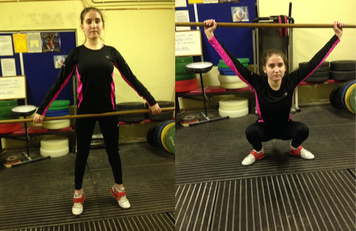 Where the barbell/ pole should be held: With straight and relaxed arms (just below the waist). The elbows should be out. Foot placement: The lifter should be on their toes before squatting down. With heels flat on the ground, the lifter should squat and hold the position for roughly 10 seconds. Head placement: The lifter should be looking straight ahead at all times. Repetition number: This should be repeated three to four times. Mistakes to look out for: The lifter should try to squat as low as possible. The bar shouldn't move in front of or behind the head, it should remain above the head. The lifter should keep the bar close to the body and not let it swing out away from the body. Fourth movement Where the barbell/ pole should be held: On the top of the knee caps Foot placement: The lifter should have their feet flat on the ground, then move up onto their toes before dropping back into the squat. With heels flat on the ground, the lifter should squat. Head placement: The lifter should be looking a few metres away towards the ground and should not begin the lift with their head looking upwards. However, when the bar is in movement, they may look straight ahead. Repetition number: This should be repeated two to three times. Mistakes to look out for: The lifter should try to squat as low as possible. The bar shouldn't move in front of or behind the head, it should remain above the head. The lifter should keep the bar close to the body and not let it swing out away from the body. The bar mustn't scrape up the thighs or bounce off the hips, it must move vertically. 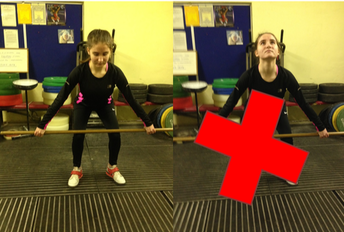 Why the head shouldn't be looking upwards: The body follows the head during most sports such as High jump. Whilst sprinting when leading up to the pole, I have often aimed my head high to get the rest of my body over the pole. With Weightlifting, having your head looking upwards can cause the bar to travel further backwards. Therefore, the momentum of the heavily weighted bar cannot always be stopped by the mere resistance of arm strength during the Snatch, causing the barbell to fall backwards behind the lifter. Clean and jerk warm upFirst movement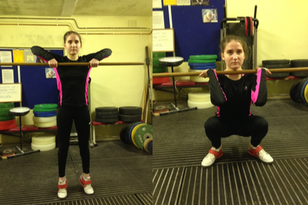 Where the barbell/pole should be held: As high up the chest as possible with the lifters hands in the clean and jerk grip, roughly shoulder width apart (narrow grip). Foot placement: The lifter should be on their toes before squatting down. Head placement: The lifter should be looking straight ahead at all times. Repetition number: This should be repeated three to four times. Mistakes to look out for: The lifter should try to squat as low as possible. The elbows mustn't touch the knees (keep the elbows high). Second movement Where the barbell/pole should be held: Tummy button height Foot placement: The lifter should be on their toes before squatting down. With heels flat on the ground, the lifter should squat. Head placement: The lifter should be looking straight ahead at all times. Repetition number: This should be repeated four to five times. Mistakes to look out for: The lifter should try to squat as low as possible. The elbows mustn't touch the knees. Third movement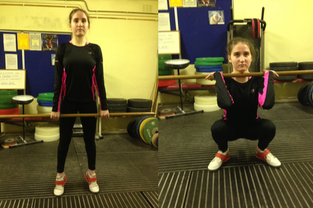 Where the barbell/ pole should be held: With straight and relaxed arms (just below the waist). The elbows should be out. Foot placement: The lifter should be on their toes before squatting down. With heels flat on the ground, the lifter should squat and hold the position for roughly 10 seconds. Head placement: The lifter should be looking straight ahead at all times. Repetition number: This should be repeated three to four times. Mistakes to look out for: The lifter should try to squat as low as possible. The elbows shouldn't touch the knees. The lifter should keep the bar close to the body and not let it swing out away from the body. Fourth movement Where the barbell/ pole should be held: On the top of the knee caps Foot placement: The lifter should have their feet flat on the ground, then move up onto their toes before dropping back into the squat. With heels flat on the ground, the lifter should squat. Head placement: The lifter should be looking a few metres away towards the ground and should not begin the lift with their head looking upwards. However, when the bar is in movement, they may look straight ahead. Repetition number: This should be repeated two to three times. Mistakes to look out for: The lifter should try to squat as low as possible. The elbows mustn't touch the knees. The lifter should keep the bar close to the body and not let it swing out away from the body. The bar mustn't scrape up the thighs or bounce off the hips, it must move vertically. Jerk warm up (Dip and punch) Where the barbell/ pole should be held: On the shoulders and then punched up above the head. Foot placement: The lifter should have their feet flat on the ground before jerking the bar, then the split should contain their front foot flat on the ground and their back foot on their toes. Head placement: The lifter should look straight ahead of them.. Repetition number: This should be repeated four to five times. Mistakes to look out for: The lifter must lock their elbows at the top of the lift and mustn't hesitate when punching the bar up. The feet should be evenly spaced out and not in a straight line. Second movement (Foot positioning)This is a more specific alternative when moving the feet back together after the clean and jerk. Instead of moving simply your front foot back and your back foot forward I do this: 1. Lowering the back foot heel down whilst moving the front foot backwards to the beginning position. 2. Moving the back foot forward Often I'll do this to help the kids to warm up and become more stable on their feet. It is useful to place a pole on the ground or to use a straight line when jerking, this can help to identify whether the lifters feet are too close together or what is making them unstable when lifting. After each of these warm ups, I tend to run through the full lifts to spot any mistakes in the lifters technique. Thanks for reading this post, I'm very proud of it. Note that this is purely technique to be delivered to an average level and that many clubs have different preferred techniques. I've linked the downloadable videos of the lifts below.
0 Comments
Read More
Your comment will be posted after it is approved.
Leave a Reply. |
||||||||||||


